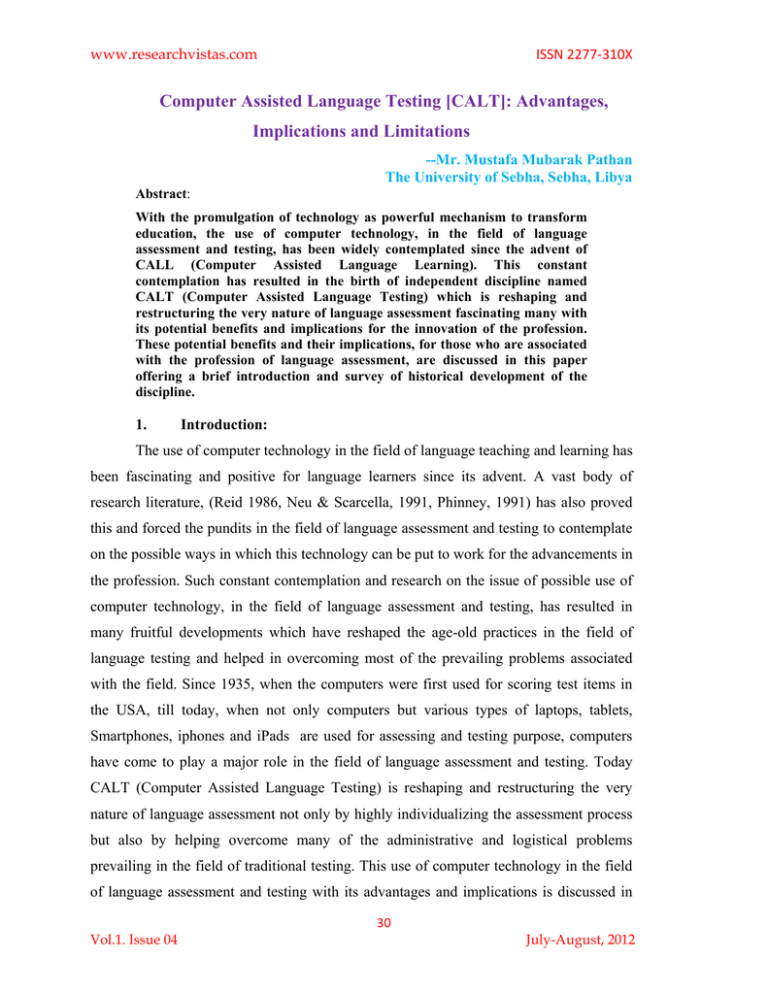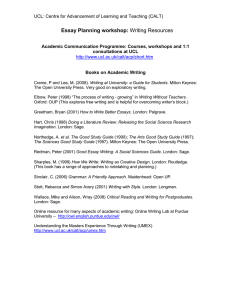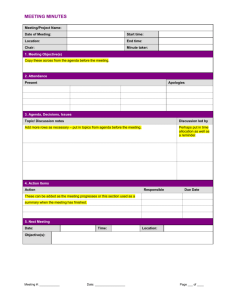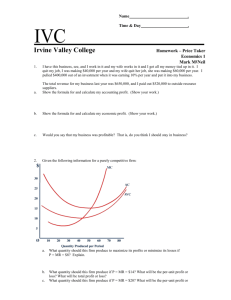advertisement

www.researchvistas.com ISSN 2277‐310X Computer Assisted Language Testing [CALT]: Advantages, Implications and Limitations --Mr. Mustafa Mubarak Pathan The University of Sebha, Sebha, Libya Abstract: With the promulgation of technology as powerful mechanism to transform education, the use of computer technology, in the field of language assessment and testing, has been widely contemplated since the advent of CALL (Computer Assisted Language Learning). This constant contemplation has resulted in the birth of independent discipline named CALT (Computer Assisted Language Testing) which is reshaping and restructuring the very nature of language assessment fascinating many with its potential benefits and implications for the innovation of the profession. These potential benefits and their implications, for those who are associated with the profession of language assessment, are discussed in this paper offering a brief introduction and survey of historical development of the discipline. 1. Introduction: The use of computer technology in the field of language teaching and learning has been fascinating and positive for language learners since its advent. A vast body of research literature, (Reid 1986, Neu & Scarcella, 1991, Phinney, 1991) has also proved this and forced the pundits in the field of language assessment and testing to contemplate on the possible ways in which this technology can be put to work for the advancements in the profession. Such constant contemplation and research on the issue of possible use of computer technology, in the field of language assessment and testing, has resulted in many fruitful developments which have reshaped the age-old practices in the field of language testing and helped in overcoming most of the prevailing problems associated with the field. Since 1935, when the computers were first used for scoring test items in the USA, till today, when not only computers but various types of laptops, tablets, Smartphones, iphones and iPads are used for assessing and testing purpose, computers have come to play a major role in the field of language assessment and testing. Today CALT (Computer Assisted Language Testing) is reshaping and restructuring the very nature of language assessment not only by highly individualizing the assessment process but also by helping overcome many of the administrative and logistical problems prevailing in the field of traditional testing. This use of computer technology in the field of language assessment and testing with its advantages and implications is discussed in 30 Vol.1. Issue 04 July-August, 2012 www.researchvistas.com ISSN 2277‐310X the following sections of the paper offering a brief introduction and survey of historical development of the field. 2. Computer Assisted Language Testing: Meaning and Nature The use of computer technology in the field of language assessment is referred to as Computer-Assisted Language Assessment or Computer-Assisted Language Testing (CALT), both the terms are used interchangeably. According to José Noijons (1994), CALT is “an integrated procedure in which language performance is elicited and assessed with the help of a computer (P.38).” This use of computer technology, in the field of language assessment and testing, falls under three major domains due to the nature of use of this technology. These include- 1] use of computer for generating tests automatically, 2] interaction of computer with the candidate (in the form of online interaction), and 3] use of computer for the evaluation of test taker’s responses. Although all these three aspects of the use of computer technology in the field of language assessment come under the domain of CALT, it was the third aspect, the use of computer for the evaluation of test taker’s responses that gave birth to CALT and later encompassed the other two, very crucial, aspects. The following section offers a brief survey of this birth and development of CALT. 3. Computer Assisted Language Testing: Origin and Development The use of computer in the field of assessment and testing practice dates back to 1935 when the IBM model 805 was used for scoring objective tests in the United States of America to reduce the labour intensive and costly business of scoring millions of tests taken each year. As the schooling provisions rapidly expanded in the USA during 1920s, the possibility of incorporation of ‘new-type tests’ in the assessment was tested and utilized to meet the need of the time. The IBM also contributed in solving this problem by developing a machine to score the multiple choice items that were used in the 'newtype tests' of the day. Since then the practical need to assess large number of people cheaply and efficiently, and the advent of technology to achieve this, remained the major theoretical concerns of testing and assessment pundits and rapid advancements in the technology, particularly in the 1980s, led to many advancements in the field of CALT as well. 31 Vol.1. Issue 04 July-August, 2012 www.researchvistas.com ISSN 2277‐310X In the 1980s, as the microcomputers came within reach for many applied linguists and item response theory (IRT) also appeared at the same time to make use of this new technology, a lot of research work took place to test the possibility of the use of computer technology for innovating the existing assessment and testing practice. The first outcome of this research work was witnessed in the form of first Computer-Adapted Test (CAT), technologically advanced assessment measures (Dunkel, 1999), in 1985. This was the result of ground-breaking work by two enthusiasts of the use of computer technology in the field of language assessment and testing named Larson and Madsen (1985) who developed the first CAT at Brigham Young University, in the USA. They developed large pool of test items for test delivery using computers. In the Computer Adapted Test, designed by them, the program selected and presented items in a sequence based on the test taker’s response to each item. If a student answered an item correctly, a more difficult item was presented; and conversely, if an item was answered incorrectly, an easier item was given. In short, the test “adapted" to the examinee's level of ability. The computer's role was to evaluate the student's response, select an appropriate succeeding item and display it on the screen. The computer also notified the examinee of the end of the test and of his or her level of performance (Larson 1989: 278). Larson and Madsen’s (1985) above referred CAT served as an impetus for the construction and development of many more computer adapted tests throughout the 1990s (e.g., Kaya-Carton, Carton & Dandonoli, 1991; Burston & Monville-Burston, 1995; Brown & Iwashita, 1996; Young, Shermis, Brutten & Perkins, 1996) which helped language teachers in making more accurate assessment of the test taker's language ability and attracted many as it appeared to be of immense potentials both for language teachers and learners. As Item Response Theory and many computer softwares, for calculating the item statistics and providing adaptive control of item selection, presentation and evaluation, witnessed advancements, the use of computer technology in the field of language assessment and testing started becoming inevitable reality though the challenge of availability of infrastructure and the cross-disciplinary knowledge, required in the field, hampered its progress for some time at its early stage. 32 Vol.1. Issue 04 July-August, 2012 www.researchvistas.com ISSN 2277‐310X Today the use of computer technology, in the field of language assessment and testing, has become so widespread and so inclusive that it is regarded as the inseparable part of today’s education system. The web of many useful computer adapted tests [CATs] as well as web based tests [WBTs] is constantly growing and computers are used not only for test delivery but also for evaluation of complex types of test responses. Even the large testing companies, who showed little interest in the field at its early stage, have also stepped in and are producing and administrating these CATs as well as WBTs. The administration and delivery of highly popular and useful tests such as TOEFL, IELTS, DIALANG etc, to mention a few, speak volumes about the role played by computer technology in the field of language assessment today. The realm of CALT is constantly expanding and encompassing even the field of scoring and rating as well. Today computers are used not just to score objective type of test tasks but also to assess and rate much more complex task types like essays and spoken English. The Educational Testing Service’s (see http://www.ets.org), automated systems known as Criterion (see http://www.criterion.ets.org) and e-rater (see http://www.ets.org/erater), for rating extended written responses based on aspects of NLP analysis, Vantage Laboratories’ (see http://www.vantage.com), IntelliMetric, Pearson Knowledge Technologies’ (see http://www.knowledge-technologies.com) Intelligent Essay Assessor (IEA ), and Pearson’s Versant, (see http://www.versanttest.com), a computer-scored test of spoken English for non-native speakers, using NLP technology, etc. indicate how rapidly the realm of CALT is growing and reshaping, innovating and revolutionizing the field of language assessment and testing by adapting itself successfully with the new challenges in technology and assessment practice . 4. Computer Assisted Language Testing: Advantages The sophisticated and adaptive nature of computer assisted language testing has many positive aspects that can be used for the betterment of assessment process and also for overcoming many of the prevailing problems in the field of traditional testing. Many scholars like Carol A. Chapelle and Dan Douglas (2006), Dandonoli (1989), Larson (1989), Stansfield (1990), Madsen (1986,1991) have advocated the use of computer technology in the filed of language assessment and testing due the potentials advantages 33 Vol.1. Issue 04 July-August, 2012 www.researchvistas.com ISSN 2277‐310X of this technology for the field. Some of the major advantages of use of computer technology in the field of language assessment and testing are discussed below. 4.1 CALT helps in overcoming administrative and logistic burdens: The first advantage of the use of computers in language testing is that it helps overcome many of the administrative and logistic burdens associated with tradition testing practices. There are many issues associated with the traditional testing practice such as presenting oneself at a designated time and place of test, sometimes travelling many miles to take the test, shipping of test materials to different testing sites and then shipping back the responses of testers to scoring centers, and sending of the results then to test takers and score users etc. All these things imply a significant commitment of time, money and energy. The use of computer technology proves highly beneficial here and can help overcome these administrative and logistical burdens. Computer assisted testing diminishes the administrative burden of invigilating, or proctoring, by making the test available wherever and whenever the test taker can logon to the internet or can insert a disk into a CD-ROM drive. It also reduces the logistical burdens by transmitting test materials electronically. The use of the internet for test delivery in the form of web based testing or WBT has been the most significant contribution to the field of language assessment to overcome many of these logistical and administrative problems as rightly observed by Roever (2001), an enthusiast of web-based testing, in the following word: “Probably the single biggest logistical advantage of a WBT [web-based test] is its flexibility in time and space. All that is required to take a WBT is a computer with a web browser and an internet connection (or the test on disk). Test takers can take the WBT whenever and wherever it is convenient, and test designers can share their test with colleagues all over the world and receive feedback.” (P. 88) 4.2 CALT offers consistency and uniformity: Anther benefit of the use of computer technology in the field of testing can be observed in term of consistency and uniformity in the information given to the test taker about how to proceed with taking the test. In computer assisted language testing, all test takers receive precisely the same material and instructions no matter where or when they 34 Vol.1. Issue 04 July-August, 2012 www.researchvistas.com ISSN 2277‐310X take the test. This uniformity, in the instruction and in the input presented, helps the test takers in overcoming the fear and confusion during the test. 4.3 CALT assures enhanced authenticity and greater interaction: The availability of varied options in CALT, for presenting input material in various forms such as text, graphics, audio, and video, as well as user control of the input etc, is another notable advantage. In CALT, with all these features, attempt is made to simulate the target language use situation which enhances the authenticity of the test tasks by strengthening the possibility for greater interaction between the test taker’s communicative language ability and the test tasks. 4.4 CALT offers insight into test-taker’s route and strategies: Other advantage of CALT is related to technology as rightly pointed out by Alderson (1990). According to Alderson (1990), “the computer has the ability to measure time. The time which a learner takes to complete a task or even the time taken on different parts of a task, can be measured, controlled and recorded by computer.” Not only this, computer even records the information about the test taker’s routes through the test offering very useful insight into the test taker’s own strategies for evaluation. The computer can register test taker's route through a test detailing how often s/he goes back to an assignment, how often s/he corrects his answers, when s/he asks for help etc. The answers to these questions can be very useful to understand test taker’s problem-solving strategies which can be of immense help for teacher to understand the performance level of student. 4.5 CALT individualizes test experience: CALT tailors and adapts the test to the individual test taker’s level of language ability by selecting the next item to which a test taker is exposed in the light of his or her response to the previous item avoiding challenging test taker far beyond his/her capability by selecting hems at the appropriate difficulty level. This makes the test taking experience highly individualized. 4.6 CALT provides self-pacing: Computer adaptive tests are not limited in time and can be taken at the test taker’s convenient location, at convenient time, and without human intervention allowing the examinee to work at his/her own pace. 35 Vol.1. Issue 04 July-August, 2012 www.researchvistas.com ISSN 2277‐310X 4.7 CALT guarantees immediate test results and feedback: Immediate test results and feedback complete with a printout of basic testing statistics and accuracy in reporting test scores is other advantage of using computer technology in the field of assessment. 4.8 CALT provides more accurate assessment of the test -taker’s language ability: A more accurate assessment of the test taker's language ability, with the help of psychometric calculations, is probably the most important advantage of CALT which offers infinite potentials both for teachers and learners. Computers can compute which assignment (from an item bank) would fit best with the candidate's measured ability so far and present the test that suits to his/her language ability. 4.9 CALT provides improved test security: The vast data of test items, in the form of item pool, helps in providing completely different tests for each student which, in turn, help solving the problem of cheating as no information, that would directly help other students, can be passed around. 4.10 CALT requires less time to finish: Many researches [Madsen, (1991),Kaya-Carton, Carton, & Dandonoli, (1991), and Laurier(1999)] have also proved that computer assisted tests require less time to finish, compared to the traditional paper-and-pencil tests. This can also be described as another important advantage of CALT. 4.11 CALT creates a more positive attitude toward tests: Computer assisted tests are shorter and require less time to finish as well as the questions submitted are neither too easy nor too difficult. This helps in creating more positive attitude toward the test. Madsen’s study (1986), which found that among the students taking both a paper-and-pencil test and a computer adaptive test 81% expressed a more positive attitude toward CALT, can be taken to support this. 4.12 Other advantages: Computers also offer test taker various helps on the screen such as the way s/he should proceed, by clicking ‘help’ button, spelling check, help on syntactic errors in the learner’s text etc. And last but not least, testing large number of people faster, accurately, 36 Vol.1. Issue 04 July-August, 2012 www.researchvistas.com ISSN 2277‐310X quickly, efficiently and cheaply, overcoming the barriers of time and place, is also important advantage of CALT. Perhaps the understanding of these benefits embedded in CALT, for the field of assessment, is making it more popular and widespread in today’s education system. The above mentioned, advantages and benefits, if studied carefully, have many possible implications for the field of assessment and testing and can be exploited for innovating it as well as to overcome many of the problems prevailing in the field. 5. Implications of CALT: The above mentioned advantages of CALT have many implications for all those who are associated with language assessment and testing practice. These implications of CALT can be categorized under three major domains- 1] Implications for academic institutions 2] Implications for language teachers and 3] Implications for language learners. These can be specified as follow5.1 Implications for academic institutions: The use of computer technology, in its present highly advanced form, in the field of language assessment and testing can be of immense help in overcoming many of the administrative and logistical burdens, mentioned in the previous section, associated with the traditional testing practice. Every academic institute has to employ immense resources for administrating and delivering tests to the students every semester/year. This implies financial costs and human resources. Despite spending a lot of money and employing several human resources, the academic institutions fail to provide accurate and fast results to the test takers. This problem becomes worse in large academic institutions with thousands of students. Assessing this large number of students often results in flawed assessment of test taker’s language ability and prolonged duration to provide the results. CALT can be a helping hand to the academic institutions in overcoming this problem by saving lots of resources, both financial and human, and by making the assessment faster and more accurate and efficient. CALT can offer the results of the assessment within minutes with detail analysis of the test taker’s performance solving many of the administrative and logistical problems associated with the traditional testing and assessment practice as well as saving lots of money and human resources. It can cater 37 Vol.1. Issue 04 July-August, 2012 www.researchvistas.com ISSN 2277‐310X to the need of assessing large number of population, in today’s education system, cheaply, more accurately, efficiently and quickly. 5.2 Implications for language teachers: In this brave new world of technology, a successful teacher is the one who adapts himself/herself with the emerging trends and technologies in his/her field and exploits them for enhancing and upgrading his/her own professional skills. Therefore, language teachers today need to literate themselves with solid understanding of the nature of CALT as it has become a regular and widely-used practice in today’s education system. CALT can be of immense help for language teachers in making correct assessment of language ability of their students. It can help them in individualizing the learning and testing processes by taking them beyond the traditional classrooms. Correct understanding of the advantages of CALT, mentioned in the previous section, can go long way in advancing the teaching and assessing practices for the language teachers. Language teachers can exploit these benefits of CALT by designing their own tests, for the courses being taught by them, which can be taken by the learners from anyplace and anytime to assess themselves at their own pace and with ease. Today many test authoring programs like Respondus, Blackboard, Questionmark, Hot Potatoes, the Discovery School Quiz Center etc, are available in market. Due to the simplified nature of these programs, any computer literate language teacher can create wonders with them by constructing teaching units, with quizzes based on it, and a means for scoring and reporting scores to students. This can help them not only in imparting innovative and dynamic teaching and testing but also in understanding strengths and weaknesses of their students as computer adapted tests provide individualized reports not only in terms of scores but also in terms of strengths and weaknesses of the students. These reports can offer immense insight into learner’s level for teacher who can then work on the strategy to help the learner overcome the weaknesses. 5.3 Implications for language learners: An innovative technology for language teaching, learning and testing has been the key feature of education system of today’s e-generation. In the age where CALL [Computer Assisted Language Learning] is going to MALL [Mobile Assisted Language Learning], every attempt is made to individualize learning and assessment practices with 38 Vol.1. Issue 04 July-August, 2012 www.researchvistas.com ISSN 2277‐310X the help of emerging technologies. Today language learners are offered immense opportunities by these emerging technologies not only to learn the language but also to assess and test their language ability at their own pace from their own place and at their suitable time. Today many useful and immensely popular computer adapted tests and web based tests such as DIALANG tests ( see http://www.dialang.org), the Center for Applied Linguistics or CAL’s Basic English Skills Test (BEST), (see http://www.cal.org/best) and the BEST Plus (see http://www.cal.org/bestplus) etc to mention, very few, are available for the learners to assess their language ability. Many edu-tech giants have also entered the field and many, highly useful, websites like Longman’s (http://www.longmanenglishinteractive.com), Pearson’s (http://www.marketleader.net, http://www.ecollege.com, http://www.myenglishlab.com), Hot Potatoes’ (http://www.hotpot.uvic.ca), Discovery School Quiz Center’s (http://www.school.discovery.com) etc. , again to mention very few, are creating and providing immense resources and self assessment activities and tests, with instant results and feedback on the weak areas of the test takers. A good language learner can capitalize on these tests to develop and master his/her language skills. The potential implication of these tests, for language learners, is that they help students to become better, more autonomous learners and feel less frightened and at ease. Hence, all those who are associated with the assessment and testing practice and hoping to improve the level of students, can put this technology to work in helping learners to identify their accomplishments and learning needs. However, one need not neglect some of the caveats that accompany any use of technology in the field of education. Though CALT has enormous advantages and potential implications for the field of language assessment and testing, there are certain issues which need equal considerations and need not be neglected. This other side of CALT is discussed in the following section. 6. Limitations of Computer Assisted Language Testing: Many researches (Canale 1986, Lange 1990; Tung 1986) have shown the limitations and pitfalls of the use of computer technology in the field of language assessment. Some of the caveats associated with the computer assisted language testing include39 Vol.1. Issue 04 July-August, 2012 www.researchvistas.com ISSN 2277‐310X 6.1 Issues related to security: Issue related to security for high- stakes tests is the first negative aspect of computer assisted language testing. The issue of identity detection of the test taker, in particular, is of major concerns. At the moment, this appears to be an insurmountable problem in high-stakes testing because score users need to be assured that the identity of the test taker is the same as the person for whom the score is reported. Therefore, highstakes tests seem reluctant to take advantage of CALT and prefer delivering tests in testing centers, where proctors can verify the identity of the test takers. Some scholars like Wainer and Eignor (2000) have also raised the security concerns about the most salient feature of CALT, computer-adaptive test or CAT. They have explained how critical items, from the item pool for the test, could be easily memorized and passed on to subsequent examinees. These issues raise the concerns about the use of computer technology in high-stakes testing and need special considerations. 6.2 Issue of technical expertise: Issues, related to technical expertise and standardization and maintenance of equipment, also raise questions about the use of CALT. Cross-disciplinary knowledge required to construct such tests, technical expertise needed, in case the system crashes, as well as costs issues, related to standardization and maintenance of equipment, limit the ambitions of CALT. Even the availability of reliable source of electricity is also another important issue of concern while using CALT. 6.3 The Constraint of medium and its negative effects on the quality of test tasks: Issues related to the constraint of medium and its effects on the quality of test tasks are also matter of concerns in CALT today. Size of the screen of computer may pose constraints on the contents of the test tasks. This is very likely when it comes to reading tests, where longer passages may have to be excluded due the problem associated with the medium. This may result in using only short passages or any other content that suits the medium and hence may affect the quality of the test tasks. 6.4 Issues related to adaptive item selection: Issues related to adaptive item selection in CAT have also raised many concerns among scholars [Canale (1986) Carol A. Chapelle and Dan Douglas (2006)] about the 40 Vol.1. Issue 04 July-August, 2012 www.researchvistas.com ISSN 2277‐310X effect of leaving item selection up to a computer program that chooses items on the basis of the level of difficulty of the items. According to Carol A. Chapelle and Dan Douglas (2006), “selection of items to be included on an adaptive test by an algorithm may not result in an appropriate sample of test content and may cause test takers anxiety (P. 41).” 6.5 Issue of inaccurate automatic response scoring: Another issue of concern is related to inaccurate automatic response scoring. Computer assisted response scoring may fail to assign credit to the qualities of a response that are relevant to the construct which the test is intended to measure. This is evident especially with the essay and speaking type tasks, where quality of linguistic response may not get awarded with appropriate score, which it really deserves. 6.6 Washback: Many critics of this technology also point out the negative impact it may have on learners, learning classes and society at large. They believe that costs associated with CALT might divert money away from other program needs. Teachers may give importance to types of tasks that appear on the test, in order to prepare their students to take the computer- based test, and if test tasks are limited, due to the constraints of the technology as mentioned above, teaching materials might be similarly limited. This may result in what Carol A. Chapelle and Dan Douglas (2006) call ‘washback’ affecting the quality of education in general. However, no concrete evidence has been recorded on washback till the date but CALT pundits need to be aware of this possibility so that required research leads in this direction also. In addition, Computer anxiety (the potential debilitating effects of computer anxiety on test performance) as pointed out by Henning (1987) is also another issue of concern in CALT which also needs to be considered. Also current restrictions on the computer’s ability to emulate natural language processing and interaction is also another issue of concern that needs significant consideration as well while using CALT. 7. Conclusion: To sum up, all the negative aspects and caveats associated with CALT mentioned so far are worthy of concern and research but they should not lead to the suspicion towards CALT. Technology can be instrumental in expansion and innovation in language 41 Vol.1. Issue 04 July-August, 2012 www.researchvistas.com ISSN 2277‐310X testing. Therefore significant body of research needs to be motivated on these areas so that, in turn, the potential benefits embedded in them can be exploited for the betterment of language testing practice in general. Since its advent, CALT has changed and innovated the existing testing practices, to make them in line with the needs of the 21st century e-generation of second language learners by making them more flexible, innovative, individualized, efficient and fast. Perhaps the realization, of these benefits embedded in it and their implications, is making it integral part of today’s education system to make testing practice more flexible, innovative, dynamic, efficient and individualized as well as to enhance the quality and standard of education. Technology creates opportunities for reflection on the development and evaluation of innovation in the profession as a whole. In the form of CALT, we are witnessing these opportunities for the reflections and need to capitalize on. References: Alderson, J. C. (1988). Innovations in language testing: Can the microcomputer help? Special Report No 1 Language Testing Update. Lancaster, UK: University of Lancaster. Alderson, J. C. (1990). Learner-centered testing through computers: Institutional issues in individual assessment in J. de Jong & D. K. Stevenson (eds.) Individualizing the assessment of language abilities. Clevedon, UK: Multilingual Matters. Alderson, J. C. (2000). Assessing reading. Cambridge: Cambridge University Press Bennett, R. E. (1999a). How the Internet will help large-scale assessment reinvent itself. Education Policy Analysis Archives, 9(5), 1-25. Bennett, H. B. (1999b). Using new technology to improve assessment. Educational Measurement: Issues and Practice, 18(3), 5-12. Blackboard. www.blackboard.com (Accessed 23 June 2012). Brown, A. &Iwashita, N. (1996).The role of language background in the validation of a computer- adaptive test. System, 24(2), 199-206. Burston, J. & Monville-Burston, M. (1995). Practical design and implementation considerations of a computer-adaptive foreign language test: The Monash/ Melbourne French CAT. CALICO Journal, 13(1), 26-46. Canale, M. (1986). The promise and threat of computerized adaptive assessment of reading comprehension. In C. Stansfield (ed.), Technology and language testing (pp. 30-45). Washington, DC: TESOL Publications. 42 Vol.1. Issue 04 July-August, 2012 www.researchvistas.com ISSN 2277‐310X Carol A. Chapelle and Dan Douglas (2006) Assessing language through computer technology Cambridge: Cambridge University Press. Center for Applied Linguistics: www.cal.org (Accessed 10 June 2012). Chalhoub-Deville, M. & Deville, C. (1999). Computer adaptive testing in second language contexts. Annual Review of Applied Linguistics, 19, 273-99. Chapelle, C. A. (2001). Computer applications in second language acquisition: Foundations for teaching, testing, and research. Cambridge: Cambridge University Press. Chapelle, C. A. (2003). English language learning and technology: Lectures on applied linguistics in the age of information and communication technology. Amsterdam: John Benjamins Publishing. Clark, J. L D. (1989). Multipurpose language tests: Is a conceptual and operational synthesis possible? In I.E. Alatis (ed.), Georgetown University Round Table on Language and Linguistics. Language teaching, testing, and technology: Lessons from the past with a view toward the future (pp. 206-15). Washington, DC: Georgetown University Press. Corbel, C. (1993). Computer-enhanced language assessment. In G. Brindley (Series ed.) Research Report Series 2. National Centre for English Language Teaching and Research, Marquarie University, Sydney, Australia Dandonoli, P. (1989). "The ACTFL Computerized Adaptive Test of Foreign Language Reading Proficiency." Modern Technology in Foreign Language Education: Application and Projects, edited by F. Smith. Lincolnwood, IL: National Textbook. DIALANG. www.dialang.org (Accessed 20 June 2012). Discovery School: www.school.discovery.com (Accessed 29 June 2012). Dunkel, P. (ed.) (1991). Computer-assisted language learning and testing: Research issues and practice. New York: Newbury House. Dunkel, P (1999). Research and development of a computer-adaptive test of listening comprehension in the less commonly-taught language Hausa. In M. Chalhoub-Deville (ed.), Development and research in computer adaptive language testing (pp.91-121) Cambridge: University of Cambridge Examinations Syndicate/Cambridge University Press. Educational Testing Service. www.ets.org (Accessed 18 June 2012). Hambleton, R. K., Swaminathan, H. & Rogers, H. J. (1991). Fundamentals of item response theory. London: Sage Publications. Henning, G. (1987). A guide to language testing: Development, evaluation, research. 43 Vol.1. Issue 04 July-August, 2012 www.researchvistas.com ISSN 2277‐310X Cambridge, MA: Newbury House. Hot Potatoes: www.hotpot.uvic.ca (Accessed 12 June 2012). Howell, S.L. and Hricko, M. (eds.): 2006, Online Assessment and Measurement: Case Studies from Higher Education, K-12 and Corporate. Idea Group, Hershey, PA IBM Corporation. (2002). They Also Served: An Album of IBM Special Products, Vol. 1. Kaya-Carton, E., Carton, A. S. & Dandonoli, P (1991). Developing a computer- adaptive test of French reading proficiency. In P. Dunkel (ed.), Computer- assisted language learning and testing: Research issues and practice (pp. 259-84) New York: Newbury House. Lange, D. L. (1990). 'Priority Issues in the Assessment of Communicative Language Abilities." Foreign Language Annals 23 403-407. Larson, J. W. & Madsen. H. S. (1985). Computer-adaptive language testing: Moving beyond computer-assisted testing. CALICO Journal, 2(3), 32-6. Larson, J. W. & Madsen. H. S. (1989). “S-CAPE: A Spanish Computerized Adaptive Placement Exam." Modern Technology in Foreign Language Education: Application and Projects, edited by F. Smith. Lincolnwood, IL: National Textbook. Laurier, M. (1999). The development of an adaptive test for placement in French. In M. Chalhoub-Deville (ed.), Development and research in computer adaptive language Testing (pp. 122-35). Cambridge: University of Cambridge Examinations Syndicate/Cambridge University Press. Laurier, M. (2000). Can computerized testing be authentic? ReCALL, 12(1), 93-104. Longman. www.longmanenglishinteractive.com (Accessed 15 June 2012). Lord, E M. (1980). Applications of item response theory to practical testing problems. Hillsdale. NJ: Lawrence Erlbaum Associates. Madsen, H. S. (1986). "Evaluating a Computer Adaptive ESL Placement Test." CALICO Journal 4, 41-50. Madsen, H. S. (1991). Computer-adaptive testing of listening and reading comprehension: The Brigham Young approach. In P Dunkel (ed.), Computer-assisted language learning and testing: Research issues and practice (pp. 237-57). New York: Newbury House. Neu, J., & Scarcella, R. (1991). Word processing in the ESL writing classroom: A survey of student attitudes. In P. Dunkel (Ed.), Computer-assisted language learning and testing: Research issues and practice (pp. 169-187). New York: Newbury House. Noijons, J. (1994). Testing computer assisted language tests: Towards a checklist for CALT. CALICO Journal, 12(1), 37-58. 44 Vol.1. Issue 04 July-August, 2012 www.researchvistas.com ISSN 2277‐310X Pearson: www.market-leader.net), www.ecollege.com, & www.myenglishlab.com (Accessed 15 June 2012) Phinney, M. (1991). Computer-assisted writing and writing apprehension in ESL students. In P. Dunkel (Ed.), Computer-assisted language learning and testing: Research issues and practice (pp. 189-204). New York: Newbury House. Questionmark . www.questionmark.com (Accessed 15 June 2012) Reid, J. (1986). Using the Writer’s Workbench in composition teaching and testing. in C. Stansfield (ed.), Technology and language testing (pp. 167—88). Washington, DC: TESOL Publications. Respondus. www.respondus.com(Accessed 15 June 2012) Roever, C. (2001). Web-based language testing. Language Learning & Technology, 5(2), 84-94. Stansfield, C. (ed.) (1986). Technology and language testing. Washington DC: TESOL Publications. Tung, P. (1986). "Computerized Adaptive Testing: Implications for Language Test Developers." Technology and Language Testing, edited by C. W. Stansfield. Washington, DC: TESOL. Wainer, H. & Eignor, D). (2000). Caveats, pitfalls and unexpected consequences of implementing large-scale computerized testing. In H. Wainer etal.(2000). Computer adaptive testing: A primer 2nd edn. (pp. 271-99). Hillsdale, NJ: Lawrence Erlbaum Associates. Vantage Laboratories. www.vantage.com (Accessed 15 June 2012) Weigle, S. C. (2002). Assessing writing. Cambridge: Cambridge University Press. Young, F., Shermis, M. D., Brutten, S. & Perkins, K. (1996). From conventional to computer adaptive testing of ESL reading comprehension. System, 24(1),32-40. 45 Vol.1. Issue 04 July-August, 2012





